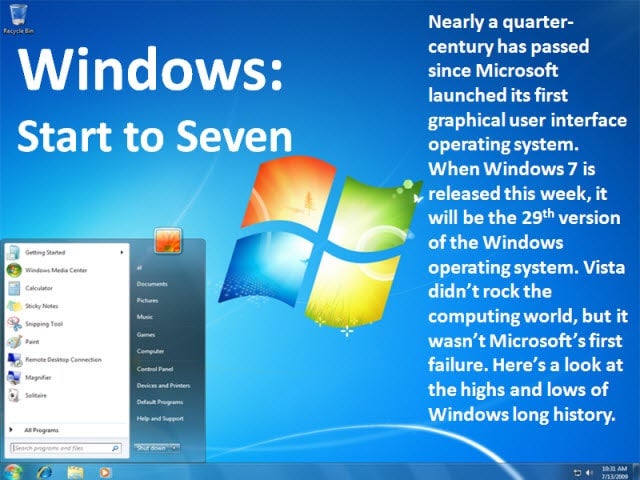 Windows Start to Seven
Windows Start to Seven
 No Title
No Title
Under pressure to compete against Apple’s Mac GUI, Microsoft developed and released Windows 1.0. It wasn’t a true operating system, but rather a navigation extension to MS-DOS. Version 2.0 was slightly more palatable to users, which caused Apple to sue for patent infringement. The market didn’t accept the platform until Windows 3.0 in 1990.
 No Title
No Title
Windows NT was built on a new kernel, meaning it was the true integration of the operating system and the GUI. It featured preemptive multitasking. It was intended as a professional version, but its features were later adapted for use in Windows XP nearly a decade later.
 No Title
No Title
Developed under the codename “Chicago,” Windows 95 (or 4.0) was more than just the full integration of the GUI and operating system for mass consumer consumption. It was the retirement package for Windows for Workgroups, Windows 3.1 and MS-DOS. Windows 95 rocketed Microsoft to computing preeminence.
 No Title
No Title
Nashville, an aborted release in the Windows line, was intended to be the first full integration of the Internet Explorer browser with the Windows platform. Microsoft wanted Nashville (or Windows 96) to stave off competition from Netscape. Nashville was scrapped in favor of a more robust integration in a later Windows release.
 No Title
No Title
In this version, NT continued as the platform for business and distributed architectures. What sets Windows NT 4.0 apart is that it’s the last version built specifically for the RISC chip architecture. Following this release, Microsoft would focus primarily on x86 chipsets.
 No Title
No Title
Developed under the codename “Memphis,” Windows 98 continued improved integration of the OS and browser, as well as support for plug-n-play functionality. Many minor fixes were resolved with the release of Windows 98 Second Edition in 1999. Windows 98 remain one of the most popular versions of the line.
 No Title
No Title
Windows Neptune was intended to bridge the consumer-oriented, DOS version of Windows 95 with the business-built NT-based Windows 2000 platform. Although Microsoft provided beta copies to testers, the OS was never generally released.
 No Title
No Title
The ill-fated Millennium Edition was intended to be the consumer complement to Windows 2000 with its slate of multimedia tools. However, critics and consumers ripped the OS for its instability and unreliability.
 No Title
No Title
Win2000 was the last Microsoft OS built on the NT architecture. Completely business and professional oriented, Win200 became one of the most successful implementations of Windows. It’s versions for desktops, notebooks and servers made it deployable across enterprise architectures.
 No Title
No Title
Windows XP ushered in the fully integrated line of operating systems for business, consumer and mobile devices. It retired the 9x architecture and provided a more stabile successor to the NT platform than Win2000. XP (short for ‘Experience’) added greater security features including an embedded firewall.
 No Title
No Title
Windows Server 2003 replaced Win2000 Server and featured greater scalability, higher reliability and better performance. Windows Server 2000 provided the foundation for all subsequent server operating systems. It’s features included a built-in firewall, automated backup, improved scripting and better message queuing.
 No Title
No Title
Vista was doomed from the start. Plagued by security problems, Microsoft said Vista would be the most secure OS in its line. It took six years to complete, but failed to deliver features, performance or interoperability that businesses and consumers desired.
 No Title
No Title
Windows Server 2008 is the first 64-bit only operating system released by Microsoft. Building upon the success of Windows Server 2003, this version features full functionality for Active Directory, virtualization optimization, IIS 7.5 and the ability to support dozens of processors in parrallel.
 No Title
No Title
While still in development, Windows Azure is Microsoft’s first foray into cloud computing. The cloud platform is designed to support multitenant applications in the cloud and in on-premise data centers. This OS uses Microsoft’s Hyper-V virtualization hypervisor and Windows Server 2008 to support cloud-based services.
 No Title
No Title
The much anticipated release of Windows 7 comes two years after the release of Windows Vista. While built on the Vista platform, Win7 has a much smaller memory footprint and processor consumption than its predecessors. Many expect Win7 will not suffer from the lack of support from third-party software.
 No Title
No Title
Even as the Microsoft world is gearing up for the release of Windows 7, word leaked that Microsoft is already working on Windows 8. Few details are available about this version and there’s no planned release date as yet.

